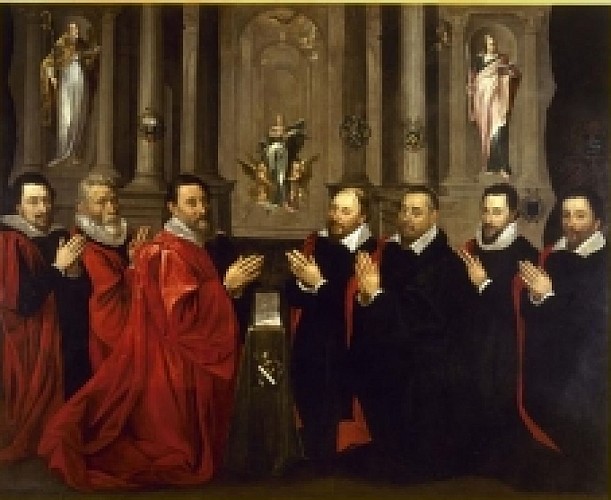The traders of the water

Description
In front of the importance of Paris, on the political level, financier and trader, king wishes to keep the control of Paris, he grants middle-class person's privileges of king and grants favors to the Hanse of the traders of the water which is so imperative with other corporations as a political power. He obtains from this fact a head office, the visiting room of the traders, a commercial court and the right to raise the tax. In 1258, Saint-Louis removes the provostship of the hands of the traders and confides it to a close relation, Étienne Boileau. In 1263, the Hanse of the traders elects a first municipality compound of a provost of the traders, whose name we ignore.
This powerful corporation of Nautes or the Traders of the water possesses skills limited to the commercial domain and was a holder of the monopoly of the supply by waterway. The provost of the traders, assisted by four aldermen, took care of the supply of the city, the public works, the plate of the taxes and had the jurisdiction on the river business. In the Middle Ages, the traders trained an association and had given themselves a regulation which they discussed in the visiting room of the traders and which they asked a provost to make apply.
Technical informations
3.7 km
|
max. 58 m
min. 27 m
24 m
| |||
Accessibility | ||||
Styles : BaladeDiscoveryIn townUnusual Public : FamilySeniorsTeenagersCyclists Themes : CulturalPatrimonyTourism of memory | ||||
Altimetric profile
Starting point
Points of interest

Statue of Étienne Boileau, one of the first provosts of Paris
Étienne Boileau whose statue is situated on the 1st floor to the left of the central detached house was named provost of the traders of Paris by 1261 by king Louis IX who had completely reorganized the administration of Paris.

Statue of Étienne Marcel
The provostship of Étienne Marcel marked the peak of the political role of the provost. After his failure, the powers of the provostship were decreased, then, in 1383 after the revolt of Maillotins, this one was deleted and united with the provostship(military police) of Paris; the jurisdictions of the jobs were then dissolved.

The last provost of the traders
Commemorative tablet marking the location of the hotel where lived Jacques de Flesselles in N°52 of the street of Sévigné. The last provost of the traders, Jacques de Flesselles, was murdered on July 14th, 1789 by the revolutionaries who took the City hall, established the first municipality of Paris and indicated to replace him Jean-Sylvain Bailly with mayor's title.

Visiting room to the Middle-class persons, "Parloir aux Bourgeois"
The corporation of nautes " the traders of the water " had obtained a jurisdiction installed in the xiiie century in the " Visiting room to the Middle-class persons " situated near the Pantheon, in the location of the current N 20 of the street Soufflot. The middle-class persons obtained a Provost of the traders whose skills were limited to the commercial domain. The provost of the traders, assisted by four aldermen, took care of the supply of the city, the public works, the plate of the taxes and had the jurisdiction on the river business. The first provost of the traders of Paris was Evrard de Valenciennes.
Data author
The Cirkwi brief
Curated by Balades Fluviales Fabienne Lemoine Fondateur, this walking adventure is not just a journey through the bustling streets of Paris but a voyage back in time revealing the city's trade lifeline. The remarkable story of the Nautes, Paris’s influential water merchants, sets the stage for an enticing exploration. These guardians of the Seine ensured the city's prosperity through their control over river trade, making their legacy an intriguing chapter in Paris's history. As you stroll, envisage the vibrant market scenes that once thrived here, under the watchful governance of a system established by none other than Saint Louis himself.
Brief Technical Overview
Spanning 3.721 kilometers, this trek presents a modest challenge suitable for enthusiasts of all levels. With the highest elevation reaching 58 meters above sea level and a minimum at 27 meters, participants will navigate a positive gradient ranging from 44 to 25 meters. This meticulous planning underscores the route's accessibility, allowing adventurers to immerse fully in the historical narrative without the preoccupation of strenuous physical demands.
Seasonal Tips for Travelers
Regardless of when you visit Paris, this journey offers unique charms each season. Spring and autumn provide crisp, comfortable weather ideal for walking, whereas summer unveils the city in full bloom. Winter, although colder, presents Paris in a quieter, more introspective mood, perfect for those wishing to avoid crowds. Regardless, comfortable footwear is a must, and an umbrella or raincoat is wise, given Paris's unpredictable showers. Always ensure you're hydrated and ready for an adventure through time.
Paris: A City Steeped in History
Paris, with its illustrious past, has been a pivotal center of commerce and culture throughout centuries. The foundation laid by the Nautes, as directed by historical figures like Étienne Boileau under King Louis IX's orders, pinpoint 75004 as a key borough in administrating the city's lifeblood - the Seine. This locale thus becomes a portal, not just to Paris's commercial but also to its political evolution, illustrating the city’s transformation from a medieval powerhouse to the modern metropolis we recognize today.
Understanding Paris’s Climate
Paris enjoys a temperate climate, characterized by mild days and cool evenings. Spring (March to May) and autumn (September to November) are ideal for visiting, with temperatures conducive to outdoor activities. Expect more rain in spring, adding to the city’s charm. Summer (June to August) can be warm, but rarely uncomfortable, while winter (December to February) is usually cold, sometimes witnessing snowfall. To capture the essence of Paris against a backdrop of historical legacy, aim for a visit during these milder months when the city’s beauty is in full display, inviting exploration by foot.
